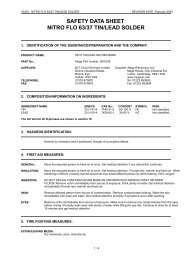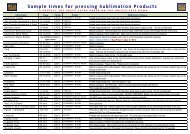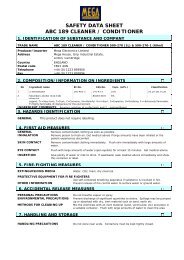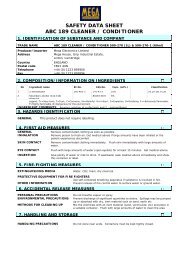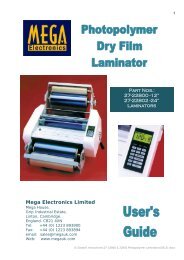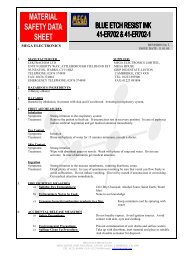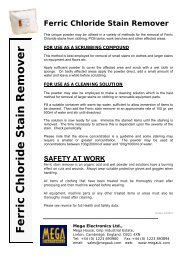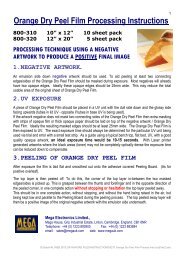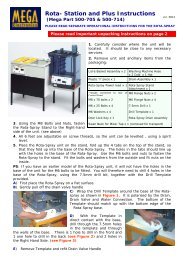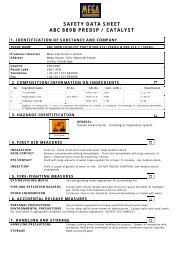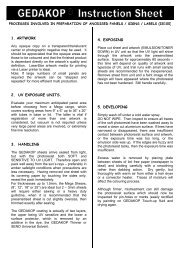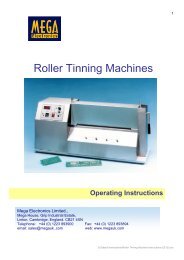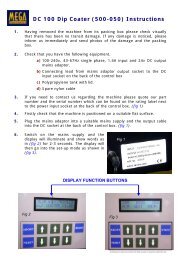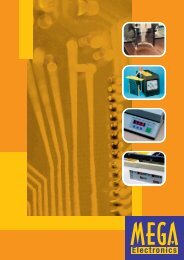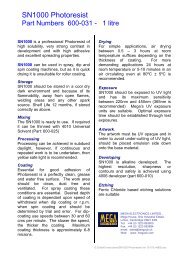SCREEN PRINTING INSTRUCTIONS - Mega Electronics
SCREEN PRINTING INSTRUCTIONS - Mega Electronics
SCREEN PRINTING INSTRUCTIONS - Mega Electronics
Create successful ePaper yourself
Turn your PDF publications into a flip-book with our unique Google optimized e-Paper software.
<strong>SCREEN</strong> <strong>PRINTING</strong><br />
<strong>INSTRUCTIONS</strong><br />
For Photo-Imageable Solder Masks and Idents<br />
Type 5600 Two Part Solder Masks and Idents<br />
<strong>Mega</strong> <strong>Electronics</strong> Ltd.,<br />
<strong>Mega</strong> House, Grip Industrial Estate, Linton, Cambridge, ENGLAND CB21 4XN<br />
Telephone +44 (0)1223 893900 Fax No: +44 (0)1223 893894<br />
email: sales@megauk.com web: www.megauk.com<br />
VERSION 08/2011
Screen Printing Instructions<br />
TABLE OF CONTENTS<br />
Overview 3<br />
Board Preparation 4<br />
Ink Preparation 4<br />
Printing the Board 4<br />
Drying he Board 5<br />
Exposing the Board 6<br />
Development 6<br />
Final Cure 6<br />
Top & Bottom Soldermask and Legend Ident. 7<br />
Step by Step process Sequence 8<br />
A NEW Bench Top Screen Printing Unit which is ideal for circuit board and non circuit board<br />
applications. For circuit boards it can be used to screen print component idents and solder masks<br />
with either conventional silk screen stencils or photo-imagable inks. The height adjustment and<br />
registration aids also make it ideal for conventional screen printing on a whole host of materials<br />
including front panels and nameplates etc.<br />
The Screen Printer allows different screen sizes from 230mm wide to a maximum external frame<br />
size of 508mm x 660mm (20" x 26") to be accommodated. Frames are held by a unique clamp<br />
which can be adjusted for frame thicknesses from 46mm to 20mm.<br />
This new screen printer has many unique design features. For instance the fitted Silk Screen<br />
Frame pivots in a polymer hinge block which eliminates all unwanted "play" to allow accurate<br />
stable screen printing. Stability during printing is further enhanced by height adjustable carriage<br />
having a four point single element clamp device mounted on two rigid columns. This height<br />
carriage allows the screen to be raised to allow the printing of materials to 75mm thick.<br />
The actual printing bed or Base Board sits on a fine adjustment mechanism to aid registration<br />
which allows a 0 - 15mm movement in both the X and Y directions. This stable 19mm solvent<br />
resistant Base Board can be removed for easy cleaning or replaced using the four threaded fittings<br />
with a customers own base board or printing jig.<br />
For long term durability the complete unit is manufactured in a fabricated welded heavy steel<br />
construction with a durable powder coat finish.<br />
Approx dimensions: 670mm x 655mm x 70mm<br />
Approx weight: 23kg<br />
Page 2
Screen Printing Instructions<br />
1. Thoroughly clean the screen mesh using the universal solvent 600-02 then dry<br />
it. Use with 71T mesh for printing solder masks and screen with 120T mesh for<br />
printing legend idents.<br />
2. Place the PCB to be printed approximately in the centre of the frame and tape<br />
three (3) pieces of board, the same thickness as the PCB material, and about<br />
25 mm wide to the screen printing table base so that the PCB is held in<br />
position. This is done before the PCB has been cut to its final size.<br />
3. Lower the frame down over the PCB and using 2” packing tape, mask the<br />
screen off leaving a clear area of mesh over the PCB which is about 10 mm<br />
smaller on each side than the PCB as shown below: (fig 1a and fig 1b)<br />
3 strips board same thickness as PCB<br />
Screen printer base<br />
Frame with mesh on underside<br />
Mashed off area<br />
fig. 1a<br />
Clear area of Mesh<br />
PCB<br />
fig. 1b<br />
Clear area of<br />
Mesh<br />
PCB<br />
4. The frame height should be adjusted so that the bottom of the mesh is 4-5 mm<br />
above the surface of the PCB<br />
N.B.<br />
Frame with mesh<br />
1) If the mesh is sticking to the PCB board<br />
surface when printing increase the distance.<br />
2) If unnecessary pressure is having to be<br />
applied to the squeegee when printing<br />
P.C.B.<br />
reduce the distance.<br />
Screen printer with base<br />
5. You are now ready to print your<br />
soldermask and legend (component identification) patterns.<br />
Page 3
Screen Printing Instructions<br />
RECOMMENDED PROCESS SEQUENCE<br />
1. BOARD PREPARATION<br />
a) Bare Copper Scrub clean well with Scotchbrite pad, rinse and dry.<br />
b) Immersion Tin:- No cleaning necessary<br />
2. INK PREPARATION<br />
b) Type 5600 - Mix as per instructions on the pack 3 parts ink with 1 part Catalyst<br />
in the mixing cup provided for Green and 4 parts ink and 1 part of catalyst for<br />
White.<br />
i.e. 4 teaspoons ink and 1 teaspoon of catalyst.<br />
Stir thoroughly and allow to stand for 15 minutes before using.<br />
NOTES<br />
a) When mixed the ink maybe used up to 24 hours after mixing if kept<br />
from U.V. light.<br />
b) Normally the ink is ready to use, but, printing characteristics can be<br />
modified by adding up to 2% BC Thinners.<br />
3. <strong>PRINTING</strong> THE BOARD<br />
Side 1<br />
(bottom soldermask, green ink)<br />
Place a thin layer of ink on the mesh, just above the clear<br />
mesh area and along the length of the clear area (see fig. 3).<br />
fig. 3<br />
fig. 3<br />
INK<br />
CLEAR AREA<br />
With the squeegee blade placed behind the ink layer and held at an angle of 45º<br />
(see fig. 4) – Press the squeegee firmly down, so that it touches the top positioning board and<br />
in one even movement, pull the squeegee across the clear area, keeping an even pressure and<br />
then release pressure when squeegee passes the other end of the clear area (see fig. 4).<br />
45º<br />
excess ink<br />
after printing<br />
DRYING<br />
fig. 4<br />
screen<br />
mesh<br />
Squeegee<br />
Squeegee rubber blade<br />
Ink<br />
mesh clear<br />
area<br />
Screen Table<br />
Positioning<br />
Board<br />
Page 4
Screen Printing Instructions<br />
4. DRYING THE BOARD<br />
a) Remove the board from the printer base and place it in an oven for<br />
15 minutes between 70º - 75ºC.<br />
N.B.1. DO NOT EXCEED 75ºC<br />
N.B.2. If only one board required, and you need a top side soldermask, remove any<br />
residue ink from clear mesh area with universal solvent to avoid mesh holes being<br />
blocked up when printing top side<br />
b) Remove the board from the oven and allow to cool down to room temperature (5 – 10<br />
minutes).<br />
c) Return the board to the screen printer and print Side 2 with soldermask<br />
ink, if topside needs a soldermask. If not, change the 71T screen for the 120T screen<br />
and mask off non print area as for soldermask.<br />
Print White legend ink.<br />
N.B. White ink is mixed in exactly the same way as the soldermask ink.<br />
d) Place the board and dry in the oven for 20 minutes, then remove from the oven and<br />
allow it to cool down to room temperature, when it will be touch dry.<br />
N.B. Total drying time for both sides should not exceed 45 minutes.<br />
At this stage the board could be held for up to 24 hours before exposure.<br />
5. EXPOSING THE BOARD<br />
a) Using a positive artwork of your soldermask pads i.e. solid pads on transparent<br />
background, which should be produced on our orange dry peel film, as this enables you<br />
to see the holes through the solid orange pads. align the artwork to the holes and tape<br />
it in position on the board. Turn the board over and align the top side soldermask<br />
(upside down copy of bottom side) over the holes and tape down.<br />
If the topside soldermask is not required, then take the legend ident. artwork, which<br />
should be a negative orange film, i.e. clear areas on orange background and register as<br />
for soldermask.<br />
b) Place board in U.V. exposure unit and expose (40 – 60 Seconds in a <strong>Mega</strong> UV).<br />
6. DEVELOPMENT<br />
a) This is done by placing the board in a tray or <strong>Mega</strong> heated process tank e.g. Developing<br />
tank in PB710 using our dry film developer concentrate 4615 (part no 500-164) diluted<br />
25 : 1 with water, with a temperature between 30º - 40ºC<br />
b) Mechanically agitate the board in the developer until pad areas and holes are clear of all<br />
photo-imageable resist. Normally 2 – 3 minutes.<br />
c) Rinse the board thoroughly and then dry it.<br />
Page 5
Screen Printing Instructions<br />
7. FINAL CURE<br />
a) Place the board back in the oven and leave for 30 – 40 minutes at 145º - 150ºC<br />
b) Remove board from the oven and allow to cool down.<br />
8. TOP AND BOTTOM SOLDERMASK AND LEGEND IDENT.<br />
a) Proceed up to and including final cure stage for the top and bottom soldermasks<br />
on side 1 and side 2.<br />
b) Print down the legend ink and dry. Expose (using negative artwork) and<br />
develop as instruction 2 - 6 above.<br />
c) Then oven dry the board again for 30 minutes at 145º - 150ºC.<br />
Finally note the following points:-<br />
1. All printing and exposing processes should be done in subdued or yellow light<br />
conditions i.e. there should be no direct ultra-violet light present. Also after<br />
exposure the board should be kept in a drawer or black bag if it is not going to<br />
be developed immediately.<br />
Maximum time printed board can be kept before exposure is 24 hours<br />
2. If after development and before final cure a mistake has been made, you can<br />
strip off the ink with our Resist Stripper (part no. 600-019) at 40º -50ºC.<br />
3. Clean ink from mesh using our universal solvent (part no 600-024).<br />
ENVIRONMENT PROTECTION<br />
Recycle unwanted materials instead of disposing of them<br />
as waste. All equipment, accessories and packaging<br />
should be sorted, taken to a recycling centre and disposed<br />
of in a manner which is compatible with the environment.<br />
Page 6
Screen Printing Instructions<br />
STEP BY STEP PROCESS SEQUENCE<br />
MIX REQUIRED AMOUNT OF INK WITH CATALYST<br />
(3 PARTS INK : 1 PART CATALYST)<br />
EXCEPT FOR WHITE IN 4 PARTS INK : 1 PART CATALYST<br />
MASK <strong>SCREEN</strong> MESH(S) EXCEPT IN REQUIRED PRINT AREA<br />
PLACE SCRUBED CLEAN BOARD ON PRINTER BED, BETWEEN POSITIONING STRIPS<br />
<strong>SCREEN</strong> PRINT SOLDERMASK INK ONTO SIDE 1 OF THE P.C.B.<br />
OVEN DRY AT 70ºC - 75ºC FOR 15 MINUTES<br />
ALLOW TO COOL TO ROOM TEMPERATURE AND PRINT SIDE 2<br />
(SOLDERMASK OR LEGEND)<br />
OVEN DRY FOR 20 MINUTES AT 70º – 75ºC<br />
THEN ALLOW TO COOL TO ROOM TEMPERATURE<br />
REGISTER TOP AND BOTTOM ARTWORKS, POSITIVE FOR SOLDERMASKS<br />
NEGATIVE FOR LEGEND<br />
EXPOSE TO U.V. LIGHT SOLDERMASK 2 – 3 MINUTES, LEGEND 3 – 4 MINUTES<br />
DEVELOP WITH MECHANICAL AGITATION UNTIL ALL UNWANTED INK IS REMOVED,<br />
2 – 3 MINUTES (30º - 40ºC)<br />
REMOVE FROM DEVELOPER, RINSE AND DRY BOARD.<br />
WHEN SOLDERMASK IS ON BOTH SIDES IF LEGEND IS REQUIRED, PRINT DESIRED<br />
COLOUR (EG WHITE). THEN DRY IN OVEN FOR 20 MINUTES. REMOVE AND ALLOW<br />
BOARD TO COOL DOWN TO ROOM TEMP. AND THEN PROCESS AS FOR<br />
SOLDERMASK USING A NEGATIVE FILM.<br />
FINAL CURE IN OVEN FOR 30 MINUTES AT 145º – 150ºC<br />
Page 7



